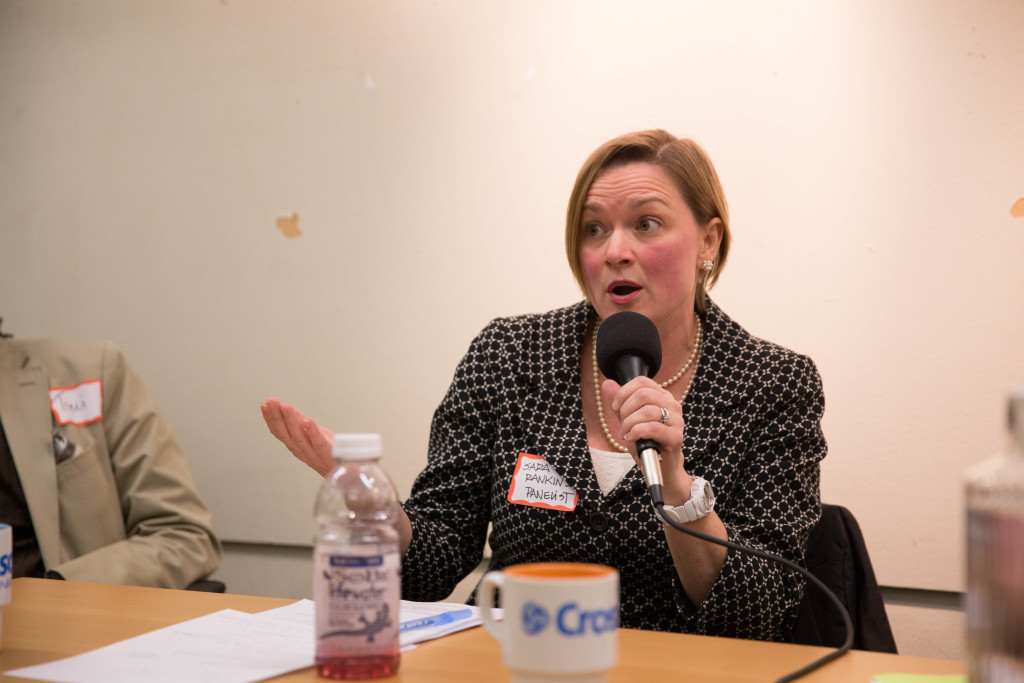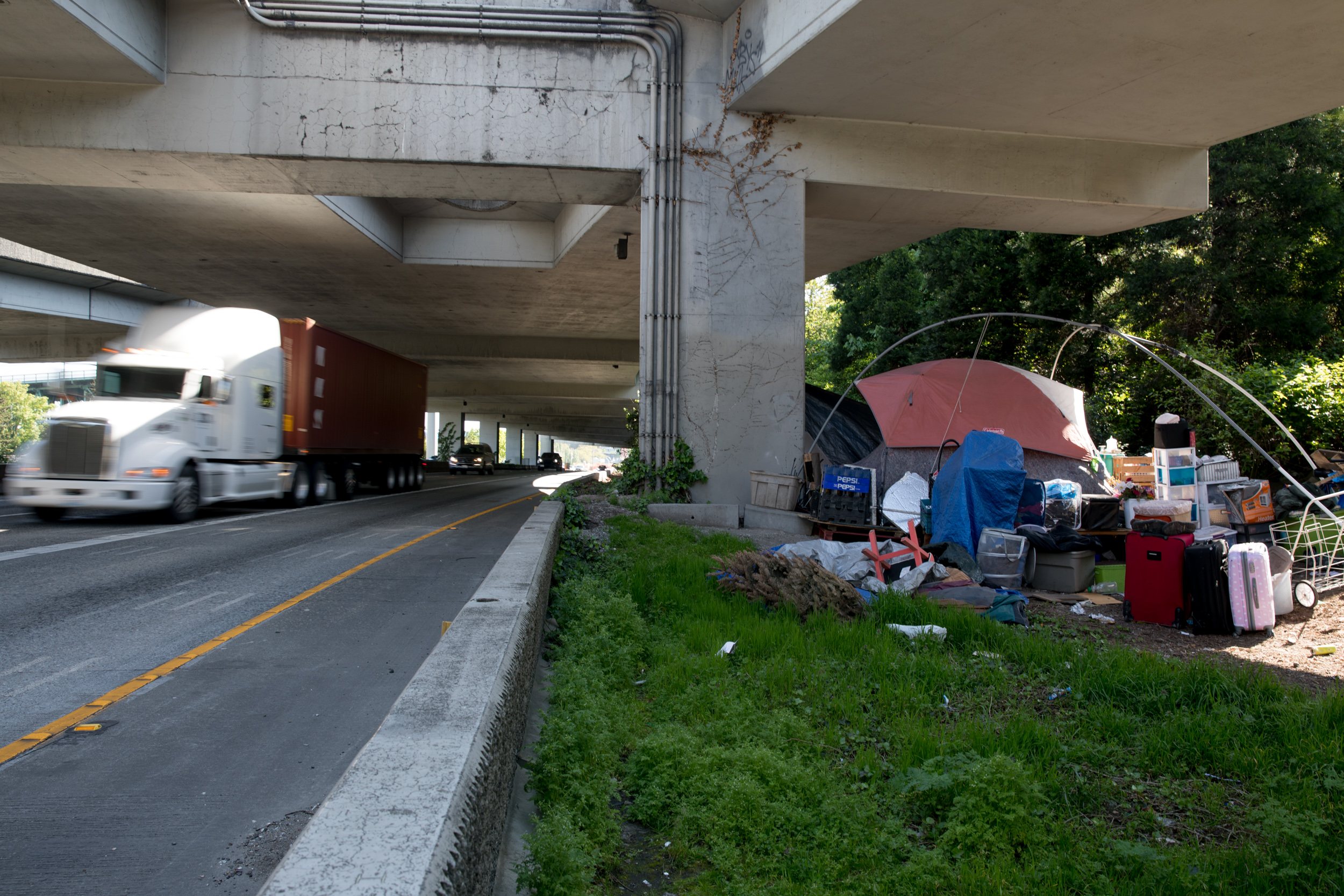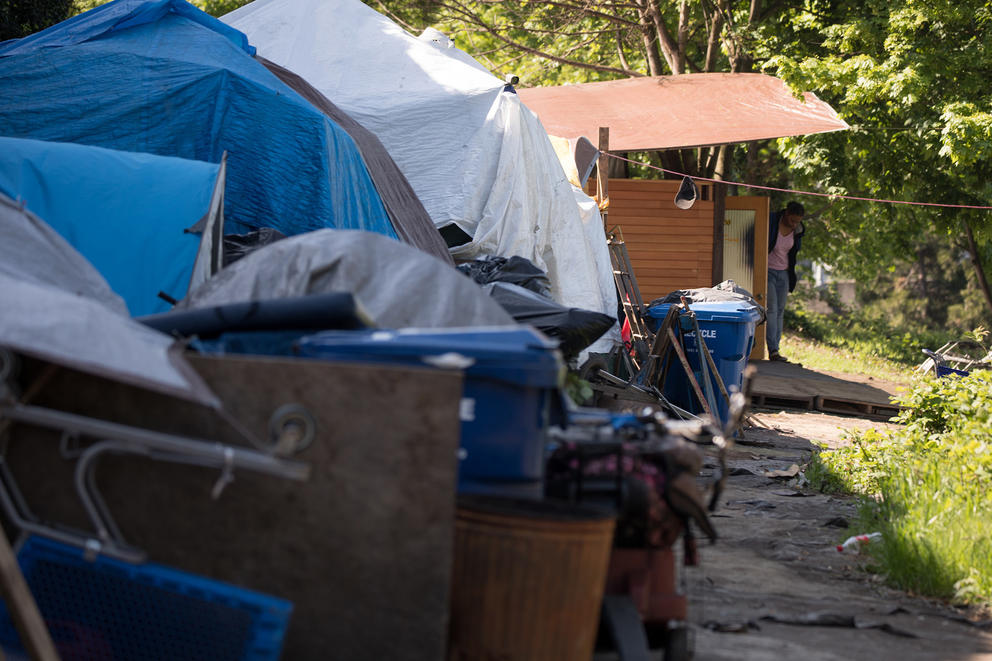Despite all the anxiety around the changes that have brought higher numbers of homeless people and increased visibility of encampments to Seattle, the solutions to combat homelessness aren’t complicated, says Sara Rankin, director of the Homeless Rights Advocacy Project at the Seattle University School of Law.
Policymakers, Rankin says, just have to be genuinely willing to make the tough, “thoughtful” decisions necessary to see those ideas materialize.
Rankin and a team of Seattle University Law School students are hoping for a little more “courage” out of local leaders as they release today new research that offers findings on what they call proven solutions and practical guidance in addressing homelessness.
The six reports span a range of topics — from exposing how detrimental and counterproductive anti-begging laws can be, to detailing best practices for some ideas to address homelessness, like safe parking programs for those living in cars and the use of accessory dwelling units to house unsheltered people.
MORE: Read each of the reports here.
Rankin recounted, “Somebody said to me the other day – actually a woman who is experiencing homelessness, [she said]: ‘You either have to choose courage or comfort, and you can’t choose both.’ I think that is Seattle’s problem.”
“We constantly choose comfort,” she continued. “People prioritize what is going to continue to make them feel comfortable as opposed to having courage and saying: What is it that I’m going to need to give up in order to really address this problem that doesn’t just affect me because I’ve been inconvenienced by the smell of urine in a subway or because I’m made upset because I’m seeing trash next to an encampment?”
Rankin, whose program has gained a high profile in recent years as the questions around homelessness have risen, said: “There’s a lot of things that we can do to address homelessness that people in Seattle just simply aren’t willing to do because it makes them uncomfortable or it makes them feel like they’re giving something up.”
“Choosing courage — and it takes courage to have that self-reflection to be able to see your own complicity in the problem — that’s something I think Seattle hasn’t done yet. We can get there. It’s going to take some work, but that’s really where we need to push.”
Crosscut spoke with Rankin about Seattle’s homelessness problem and the new research published by Seattle U. This interview has been edited and condensed for length and clarity.
Tell me a little about your research work.
“The Homeless Rights Advocacy Project works in partnership with our community partners. The way that we focus our work is to look at something that comes straight from either people experiencing homelessness, or people who work for and with people experiencing homelessness, to find out what sort of research and analysis they think they need. We’ve previously produced 10 reports. They’re all the result of, really, requests from people who are on the ground level trying to fight against homelessness every day. That’s important in terms of understanding why we select the topics that we do.”
Obviously, homelessness is a topic that’s constantly being explored and researched for solutions. What sets this new research from Seattle U’s law students apart?

“This year is a little different. Most of the reports we’ve done in the past have all been critiques of the laws. The reason that has been such a huge focus of our work in the past is, when we talk about homelessness — even our city is guilty of this — if you think about it as a two-handed problem: So often the right hand is throwing money at different projects and then ... meanwhile, the left hand is administering laws that make homelessness worse. That’s the intersection, I think, where our project comes in: To try to help cities and policymakers understand that the problem will never be solved if the left hand is undoing what the right hand is trying to work on.
What’s different in this collection: We got a lot of requests now for practical guides — where our community partners were saying ‘this is all great, we love the critiques of the law and we can use that in advocacy but we’re also finding there is a dearth of guidance on issues everybody knows something about.’ They’ve heard about different projects happening across the country, innovations to address homelessness, but they needed a more comprehensive synthesis of what these innovations are and what we can learn from those innovations.
Each of these [six new reports] is unique. There hasn’t been anything like it pulled together before. And we’re hoping that it will start to push the dialogue around the ways that different sectors of our society can get involved in solutions, instead of complaining.”
What can Seattle learn from this research as the city explores further solutions?
“One of our students probably said it best: The way the city is used to approaching homeless is fairly haphazard; some of it is throwing money at projects. The right hand and the left hand conflicting with one another. Really where we need to start is with research and with analysis. We need to think about what we’re doing before we do it.
I’ll give you an example: The city’s approach to safe parking programs, in the past, has been a complete disaster and it didn’t need to be. It could have been a successful experiment but it wasn’t because they didn’t think or plan carefully before they executed the plan. ... Basically, it was a disaster project waiting to happen, destined to fail from the moment it was pursued — and then surprise, at the end of the day, they declared it a very expensive failure and they’re not going to try it again. It sounds to me, sort of, like the way a teenager might approach a problem: Do something really quickly, and as soon as it doesn’t succeed, pulling out and saying that it didn’t work.
Thinking about it ahead of time, supported by research and analysis, means you have a better likelihood of creating a successful project. Even where you fail — even where you notice things that are not working — the answer is not always to just cut bait. Sometimes the answer is: OK, maybe we need to modify it by changing something and seeing if that tweak helps.
I think the city’s approach is often impulsive. I think the city’s approach is often geared toward increasing the comfort of people who are not facing homeless, instead of being guided by research and analysis and being thoughtful. We’ve put ourselves in this hopeless space of thinking we can’t get out of this homeless crisis. We most certainly can. Everybody knows what the solutions are: Housing jobs, mental health treatment, health care — it’s really not that complicated. It’s just that we have chosen comfort over courage.”
Why can’t we fix it if the solutions are that simple?
“One thing we know for sure works is ‘Housing First.’ ... Housing First is a proven method — repeatedly proven over and over again in multiple cities — for addressing homelessness for people who need permanent supportive housing. A lot of the people experiencing chronic homelessness or repeated homelessness are perfect for this sort of intervention. The idea of it is instead of making people prove themselves first — waiting for them to fix their lives so they ‘deserve’ housing – Housing First flips all that on its head, and says we’re going to give you housing first. And that should put you into a position where that stability will create an environment where you’re better equipped to want to go to treatment and services and in a better position to want to pursue and maintain and retain a job.
... We know that that is an approach that, if we bring it to scale, could be a huge solution to homelessness. It’s not that complicated; here’s where it falls apart: No one wants that near their house. They don’t want them in their neighborhoods. ... People just immediately respond: They don’t want density, don’t want permanent supportive housing, don’t want people who have any sort of issues or crises in their neighborhoods, because they’re so aggrieved by that possibility.”

What are a few key points from this research that you hope really hit home for folks in Seattle?
“There are three [reports] that have very concrete innovations: the accessory dwelling units, the authorized encampments and the safe parking. I’d like to see us get more serious about pursuing those sorts of interventions, because they’re proven to be successful. We know that those sorts of things work.
The ‘Begging for change’ brief is a little different, because it’s more of a critique of the law. It makes all sorts of recommendations about what cities should do with respect to begging laws.
Begging is one of the most visible ways that housed people interact with visibly poor people. What we’ve seen is that the case law is getting very difficult for cities just to say ‘we’re going to outlaw begging’ or ‘we’re going to control peaceful begging.’ It should be relatively plain to anyone who looks at the Constitution that begging is a protected form of free speech — it doesn’t matter if you don’t like how someone looks, it doesn’t matter that it makes you uncomfortable that they’re asking for help. It is part and parcel of living in an unequal society; there are going to need to be people who are asking for help.
What cities have been doing to get around that [constitutional protection] is they’re drafting these ‘aggressive begging laws’ and including in those laws non-aggressive behavior. ... And sometimes, the majority of these laws actually can be triggered just by whether someone is afraid of you. This is highly problematic, because anyone who is being honest will say that when someone who’s visibly poor approaches you and asks you for money, you feel afraid. Did that person do something aggressive? No. But does that trigger an aggressive begging violation? In many jurisdictions, yes. That is a huge problem with begging restrictions laws.”
Where do you go next with researching solutions for homeless?
“There’s not enough people doing this work and, sadly, the war on visibly poor people is really persistent. What we hope is that a couple of these will see different iterations. A few years ago, in 2015, we did the first assessment of all sorts of laws throughout the state of Washington that criminalized visible poverty. I think we’re going to be updating that study.
We’re also noticing — and this comes up in the ‘begging’ brief — another way cities are evolving in terms of social justice advancements. To avoid problems of enforcement, like enforcing the laws too vigorously, they are increasingly turning to the use of ‘move along’ warnings. ‘Move along’ warnings achieve the same outcome: You just tell people to move, so it achieves the same outcome as putting them in jail or arresting them. But there’s no paper trail, so researchers can’t tell how frequently this happens, but we know from the data we do have that it’s a pervasive practice and it still violates people’s constitutional rights. The fact that we can’t track it is highly problematic because we can’t hold policymakers accountable for engaging in that sort of type of enforcement. I think we’re going to be looking a lot at ‘move along’ warnings and how those are becoming a major form of enforcement for displacing homeless people from public space.”



